How to Make the Color Brown With Acrylic Paint
There are lots of different ways you can mix brown in acrylic painting. It is an exciting yet overlooked color with lots of options. I have mixed a lot of brown and shared what I have learned here.
To mix brown in acrylic paint mix together red, yellow and blue. Or use two colors, orange and blue. You can also mix together more unusual colors of grey & orange or grey, red & yellow. Your final color will vary depending on your color choices, the quantities of color, and the temperature of the paint.
Below I have shared lots of examples of different brown mixes and the colors that make them. These include cool browns, warm browns two and three color mixes, and some browns created with gray. Along with some examples of light and dark browns.
How To Mix Brown In Acrylic Paint

How you mix brown and what colors you use will depend a lot on the brown you are looking for for your painting. Below I have shared a lot of browns alongside them the colors I used to make them. Also, what to look for when you are mixing a brown and why you might not be getting the brown you want.
What Colors Do You Need to Make Brown?
There are lots of different ways to make browns. How you decide to do it and the type of brown you make will depend on the colors you use and in what combinations.
To make brown you need a combination of all 3 of the primary colors of red, yellow and blue to mix brown.
How you make brown using these colors can vary dramatically. I have gone through some examples below. For each one, I have varied the mixes to give you an idea of the ranges of browns depending on how much or how little of each of the colors you mix. There are of course many more colors in between each example.
Below I have included the following examples and explanations:
- 3 color brown mixes
- A how-to mix brown video
- Warm and cool brown mixes
- 2 color brown mixes
- Mixing brown using gray
- How to mix beige
3 Color Brown Mixes
Here I have given examples of 3 color brown mixes whre you use one of each of the primary colors. None of these are any from tubes that are a combined color they are all primary red, yellow and blue.
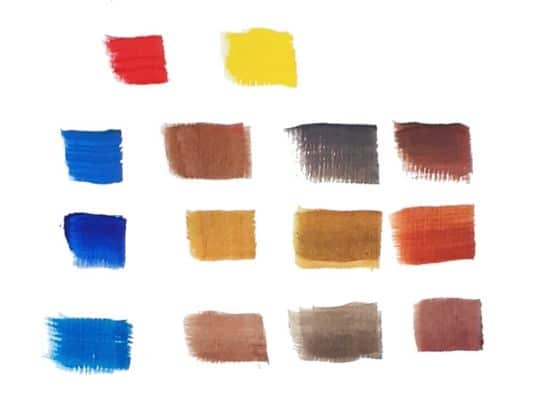
- Cadmium Red + Cadmium Yellow + Cobalt Blue
- Cadmium Red + Cadmium Yellow + Ultramarine Blue
- Cadmium Red + Cadmium Yellow + Phthalo Blue
You can see that even though I have kept the red and the yellow the same by changing the blue I used it makes quite a difference to the color of brown you get.
I have also combined the colors in varying amounts. This gives you a better idea of the range of browns you can get form only one mix. Some of the browns lean to the red while others lean to the blue/purple range. Some are warm and some are cool. There is more about warm and cool browns in the next section.
Important Note: I do my best to make sure the colors are the same on my screen as the original however note that due to the process of photographing or printing these colors can vary slightly when you see them. In addition, each brand of paint is also slightly different.
Below is another range of browns. This time I have used a different red and yellow, in this case, napthol crimson and lemon yellow while again changing only the blue but using the same blues as in the above example.

- Napthol Crimson+ Lemon Yellow + Cobalt Blue
- Napthol Crimson + Lemon Yellow+Ultramarine Blue
- Napthol Crimson + Lemon Yellow +Phthalo Blue
Already you have 18 browns by using the three primaries. And with careful mixing and using other colors or even swapping the reds and yellows for napthol crimson and cadmium yellow or cadmium red with lemon yellow you can extend this even further.
The top two, nos 1 2 make a warm brown. No 3 is still warm because it uses only one cool color.
As you can see simply changing one of the colors each time, in this case, the blue can make a big difference as to your end brown results.
How To Mix Brown Video
I found this YouTube video by Kyle Heath Art how to mix brown. It gives you simple clear instructions on how to easily mix brown using your primary colors.
How To Mix Cool And Warm Browns With Acrylics
The two examples in the 3 color combinations are examples of warm and cool browns. I have included them below side by side for easy reference. So what is it that makes them warm and cool mixes and how do you make them?
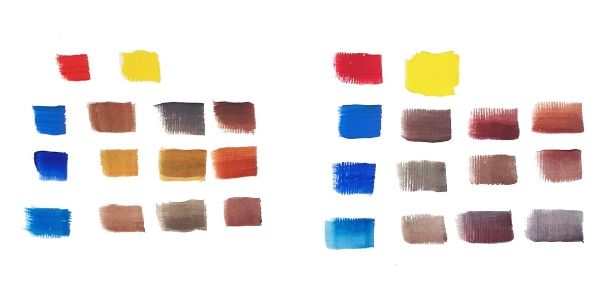
To get a cool brown you need to choose cool colors to mix to make your brown. To get a warm brown pick warmer ones. The more colors that you mix together that are cool, the cooler the brown and vice versa. You don't have to have all the colors color warm only the majority.
- Cadmium Red(W) + Cadmium Yellow(W) + Colbalt Blue (N to W)
- Cadmium Red(W) + Cadmium Yellow (W) + Ultramarine Blue(W)
- Cadmium Red(w) + Cadmium Yellow (W) + Phthalo Blue (C)
- Napthol Crimson(C) + Lemon Yellow(C) + Colbalt Blue (N)
- Napthol Crimson(C) + Lemon Yellow(C) +Ultramarine Blue(W)
- Napthol Crimson(C) + Lemon Yellow(C) +Phthalo Blue(C)
You can see from the list above that this time I have added C=cold, W=warm, N=neutral to the list to give you a better indication of which colors are warm and cool. While these colors used here are usually fairly standard if you are using other colors double check if they are cool or warm if you are unsure.
The first 3 colors using cadmium red are warm browns. To mix these I have used at least 2 warm colors in this case cadmium red and cadmium yellow. The other colors are one warm, one neutral, and one cool. With only one cool color the brown is still warmer.
I have done the same with the 2nd three colors but this time using mostly cooler colors with one neutral, warm or cool.
Although here I have used all 3 color mixes you can also use 2 color mixes as well. Just keep in mind if your double color is mostly warm. Below I have created 2 color mixes of brown. This time I have put W,C N next to each one of them to give a better indication if the colors are warm or cool.
Mix 2 Color Combination Browns
You always need the three primary colors to create your brown. But fortunately, these colors are already in the secondary colors. This gives us a huge range of opportunities to make lots of different and exciting browns using only two colors rather than three. It's quicker and easier to mix these than mixing the 3 colors together.
By using these colors our color palette really opens up. These are your basic mixes:
- Red + Yellow=Orange
- Blue + yellow = Green
- Red+Blue = Purple
From these basic colors and depending on which colors you choose and in what quantities you mix them in you can make a huge range of browns. I have painted some examples of these browns below.
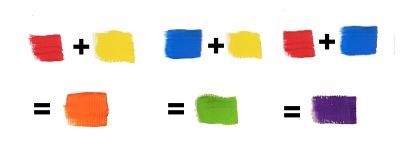
If you take any of these colors orange, green, or purple and mix it with its complement on the color wheel or missing primary color you get brown.
So to make brown you need the following:
- Orange plus blue = brown
- Green plus red = brown
- Purple plus yellow = brown
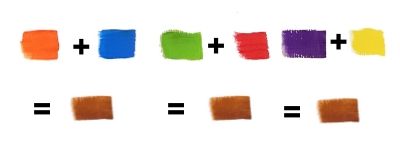
How your brown turns out will depend on which of the above colors you use. There are many different variations of orange, green, and purple and of the three 'primaries'. It's a good idea to have samples of your own mixes to work from.
Actual Working Examples of 2 Color Brown Mixes
Green Plus Red Make Brown
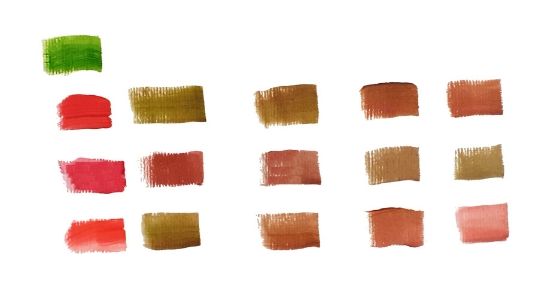
Above are the following colors:
- Sap Green (W) + Cadmium Red (W)
- Sap Green (W) + Naphthol Crimson (C)
- Sap Green (W) + Vermillion Red (W)
Here I have used a sap green which is primarily a warm yellow-green. (Mine has a touch of red as well). Remember also that whatever colors you are using will affect whether your final color is cool or warm (C or W).
Sap green has a bit of a bad reputation as being flat and dull but here it makes a good range of browns.

These are the colors above:
- Permanent Green Light (W) + Cadmium Red (W)
- Permanent Green Light (W) + Naphthol Crimson (C)
- Permanent Green Light(W) + Vermillion Red (W)
If you compare these colors with the sap green mixing they are very similar and range from an almost green to a more rich terracotta brown. Permanent green is more vibrant than sap green and lighter.
You can see on the right side that the more red I add the more terracotta affect you get.
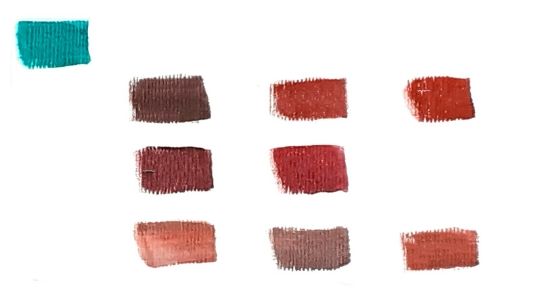
- Phthalo Green (C) + Cadmium Red (W)
- Phthalo Green (C) + Naphthol Crimson (C)
- Phthalo Green (C) + Vermillion Red (W)
Phthalo green is a very intense color you only need a small amount of it. If you use too much it makes changing the color harder. It goes from brown to green very quickly. Mix these gently.
By using a completely different green these browns come out very different from the other two examples.
Purple Plus Yellow Make Brown
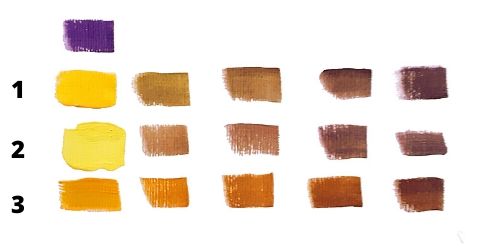
- Dioxazine Purple* + Cadmium Yellow (W)
- Dioxazine Purple* + Lemon Yellow (C)
- Dioxazine Purple* + Indian Yellow (W)
* Dioxazine Purple while typically cool can have either blue or red pigment which can alter your brown results.
Purple and yellow make great browns that are easy to mix. I have put the yellow on the left-hand side for reference as each yellow makes quite a different brown. I have used a deep violet as that seems quite common and is even included in some sets. If you want to get one similar you can use dioxazine purple. It is the same color.
The advantage of using this purple is that it is only one pigment. This cuts down your total colors which some artists prefer as they say it makes for a cleaner color the fewer colors you use when mixing.
Mix Orange and Blue Acrylic Paint to Make Brown
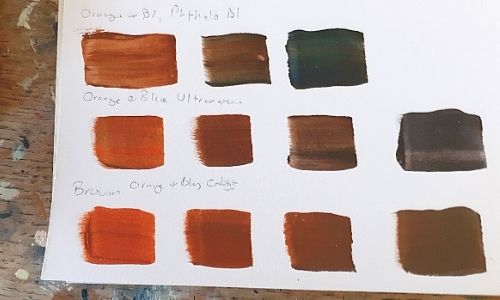
- Cadmium Orange +Phthalo Blue
- Cadmium Orange + Ultramarine Blue
- Cadmium Orange + Cobalt Blue
Here I have mixed one orange in this case Cadmium Orange (Hue) from the tube for consistency so you can see the ranges of browns you can get. Even so, this is only a small sample. I start with orange and add increasing amounts of blue. As the orange is warm whether you get a warm or cool color depends on the blue. As you can see from the right the very darks start heading towards black.
Colors That Can Be Mixed With Gray To Make Brown
The type of brown you get will depend on the gray you use. I have a warm gray which may be different from the one you have. Most people have Payne's gray which is a cooler blue-gray most of the time.
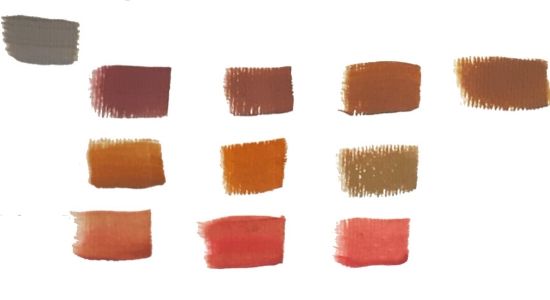
- Warm Gray + cadmium yellow
- Warm Gray + orange (perinone)
- Warm Gray + vermilion
How to Make the Color Brown With Acrylic Paint
Source: https://artpassiononline.com/mix-brown-in-acrylic-paint/
0 Response to "How to Make the Color Brown With Acrylic Paint"
Post a Comment